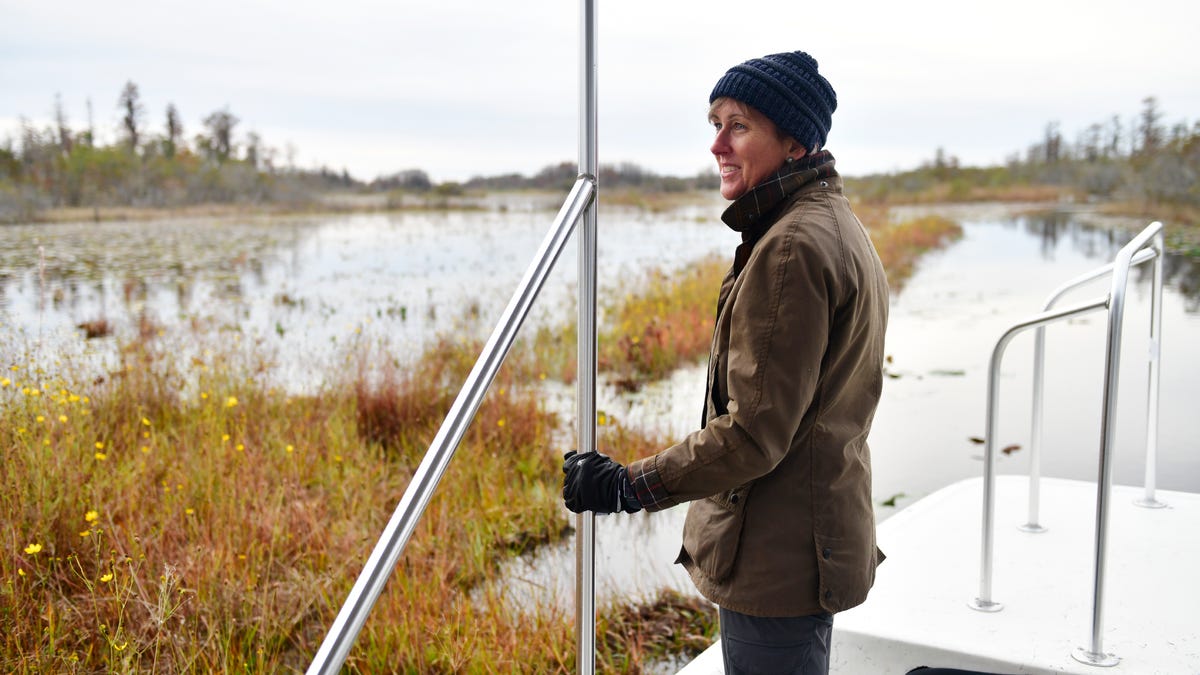World
Why does Okefenokee deserve World Heritage status? No place on earth quite like the swamp

Okefenokee Refuge hoping to become UNESCO World Heritage Site
The famed wetland is hoping to become the first in Georgia, and the 26th in the nation, as a World Heritage Site.
FOLKSTON, Ga. — Between its size and preservation, there isn’t another place quite like it on earth. It’s located not much more than an hour drive from most of Jacksonville. And yet despite that proximity, despite its existing designations, it’s also a place that most people from Jacksonville have never visited.
As Kim Bednarek knows quite well, many have never even considered it.
“People hear ‘swamp,’ and say, ‘Why would I want to visit a swamp?’” she says.
It’s a chilly, grey morning. Bednarek is at the front of a boat gliding through a corner of the Okefenokee Swamp, the largest blackwater wetland in North America.
“And then they visit the Okefenokee Swamp and see it’s beautiful,” she says, pointing to the sweeping landscape in front of her. “It’s full of light. It’s full of life. It’s not a scary place.”
Bednarek, executive director of Okefenokee Swamp Park and Adventures, isn’t just hoping to convince more people from Florida and Georgia to visit the Okefenokee. She’s among those leading an effort, more than 40 years in the making, to finally push the Okefenokee across the finish line to a coveted designation — UNESCO World Heritage site.
In September, the United States announced plans to nominate the Okefenokee National Wildlife Refuge for inscription, as UNESCO calls it, to the World Heritage list.
Why is this a big deal?
If the Okefenokee receives this designation, it would join the likes of the Galapagos Islands — the first site to be inscribed on the World Heritage list in 1978 — the Great Barrier Reef and the Grand Canyon.
It’s a designation that stamps a place as being among the world’s most important natural and cultural sites. The list includes historic sites like the Acropolis and the Pyramids, natural sites like Victoria Falls and the Canadian Rockies, and sites that have both natural and cultural significance, like Machu Picchu.
While the list has grown in the last 45 years to more than 1,000 places worldwide, there are only 25 in America. The Okefenokee would join Yellowstone and Yosemite, the Statue of Liberty and Independence Hall.
And in a couple of significant ways, the Okefenokee would be a first.
It would be the first World Heritage site in Georgia, and the only one between the Everglades in South Florida and the Great Smoky Mountains in North Carolina and Tennessee.
And it would be the first of America’s nearly 600 national wildlife refuges to become a World Heritage site.
National parks and national wildlife refuges both fall under the U.S. Interior Department umbrella. But they are separate. National refuges are managed by the U.S. Fish and Wildlife Service, not the National Park Service. In general, they aren’t as high profile as national parks, don’t have the same level of visitation, and — until now — don’t get nominated for World Heritage status.
Even making it to this point has been a long process. Established as a national wildlife refuge in 1937, the Okefenokee was identified as a potential World Heritage site in 1982. Twenty-five years later, in 2007, it was added to the United States’ “tentative” nominees list, where it stayed for another 16 years. Now it seems to finally have the momentum and backing to make it happen — beyond local efforts, Interior Department officials and bipartisan support in Congress.
But there are several big steps ahead in 2024 — the completion of formal documents for the bid — before the Okefenokee officially becomes a World Heritage site in 2025 or 2026. Maybe. Some nominees languish “under consideration” for years.
So, with all of this in mind, it seemed like a good time to go for a boat ride in the swamp to ask: What would this status mean for the Okefenokee and the region around it? What makes the Okefenokee worthy? And, more simply, what makes it a place worth visiting?
Attempt to drain the swamp failed
The drive from Jacksonville was in the predawn dark. As the urban turned to rural, the interstate to two-lane roads, it seemed to get even darker. So when the light started to change, arriving at one of the three public entrances to the Okefenokee — the one in Folkston — felt a bit like a grand reveal of tall pines and a canal leading into the swamp.
And even in the muted light of a grey morning, there was a peaceful beauty to swamp as Eric Looft steered the boat away from the dock and down a straight, manmade entry point to the swamp going back to the late 1800s.
“The canal was dug partially with prison labor,” said Looft, environmental education coordinator at Okefenokee Adventures. “They were hired for 10 cents a day. Later on they used machines. They failed when they got to Trail Ridge.”
Trail Ridge, the ancient natural rim on the east edge of the swamp, is still there today. It has been in the news lately with an Alabama-based company trying to mine near Trail Ridge, and with opponents citing scientific studies that say mining would risk permanent and irreversible impacts not only to the Okefenokee, but to so much intricately connected to it, like the St. Marys and Suwanee rivers that flow out of it.
Even though efforts to drain the Okefenokee failed, the swamp was far from untouched. In the early 1900s, before President Franklin D. Roosevelt established it as a national wildlife refuge, it was logged for 25 years. Old cypress, pine, and red bay trees were cut down.
But as Bednarek noted as the boat headed down the canal, through a canopy of today’s trees, the swamp not only remained, it recovered. The source of its water — precipitation — continues to fill its 700 square miles and flow into two rivers, making it one of the world’s largest naturally driven freshwater ecosystems.
“What makes it so profoundly unique and rare is that even though it was completely logged, it recovered … and it is now actually considered to be one of the most intact blackwater swamps globally,” Bednarek said.
When the U.S. Interior Department first made a submission that put the Okefenokee on the World Heritage tentative list, it basically argued that there isn’t another place on earth quite like this one.
The submission said: “In contrast to the Everglades and many other wetlands around the world, Okefenokee is hydrologically much more intact. This is mainly because it is the origin of waterflows, rather than their destination … The Dismal Swamp in North Carolina and Virginia has similar habitats but has been significantly influenced by human activity that changed its waterflows and essentially destroyed half of it.”
The submission mentions Brazil’s Pantanal (on the World Heritage List), the Flow Country of Scotland, Kapuatai Peat Dome in New Zealand, Indonesia’s Berbak Nature Reserve. It says these other places are different from the Okefenokee in character and in their collection of species. And it says all have been more impacted by human activity.
Dark water and dark skies
“A lot of people are shocked when they come out here and there’s no odor,” Looft says. “A few of my guys still drink the water.”
He offers a metal cup to dip into the swamp.
I pass on this, recalling memories of giardia years ago, despite filtering water in some remote mountain streams. But his point is as clear as the water is opaque: people see the dark water and think it’s dirty, when the color actually is a signature of the swamp’s health.
“It’s a blackwater swamp because of all of the peat at the bottom,” he says. “Peat is kind of the bread and butter of the swamp. It’s formed over thousands of years, and it produces the tannins that give the water its dark color.”
This is another piece of the argument for World Heritage status. Peatlands store carbon, more than twice as much as all of the world’s forests, making them important for minimizing climate change. Scientists who study peatlands already are well aware of the massive one in southeastern Georgia. One of the world’s experts, from Germany, is helping to write the final pitch for the Okefenokee.
It isn’t just a place with dark water. It has remarkably dark skies.
It’s such a large wilderness area that it’s relatively free of light pollution. And when there are clear skies and a new moon, the view of the stars is like few places in the eastern United States. The western entrance to the refuge, at Stephen C. Foster State Park, has been stamped by the International Dark Sky Association as an International Dark Sky Park.
As Looft steered the boat out of the canal, we came upon a couple of sandhill cranes. He cut the engine. And as we drifted, watching the birds before they eventually took off, Bednarek described what it’s like to spend a night in the swamp, camping on one of the platforms or the rare piece of solid ground, like Floyd’s Island.
“You hear the barred owls, and when the frogs get going it’s almost deafening,” she said. “And you wake up in the morning to the sound of sandhill cranes and bellowing alligators. … It’s a true wilderness experience.”
It was during one of those experiences — an overnight trip to Floyd’s Island in 2021 — that those on it decided to pursue World Heritage designation, convinced that the Okefenokee was worthy of the UNESCO benchmark as a site of “outstanding universal value.”
Not that, she adds, you need to spend a night in the swamp to experience the Okefenokee. Even on a short day trip, like this one, you can get a taste of it.
“If you’ve spent time in places like Alaska, you expect to have those landscapes there,” she said. “You don’t expect to find it here, too.”
From the beaches to the swamp
Bednarek, 55, has spent time in Alaska. She grew up in Boston, went to college at the University of New Hampshire — with a minor in marine biology — and ended up spending some of her 20s living in Alaska, working on fishing boats. At the other end of the temperature spectrum, she also lived in St. John in the Virgin Islands, where she studied the coral reef ecosystem.
“I’ve lived all over the country, doing a lot of different things,” she said.
She married a Floridian — her husband grew up in Gainesville — and ended up in Neptune Beach. When she was looking for a school for two sons, she found the Discovery School in Jacksonville Beach. She didn’t just send her boys there. She spent 20 years involved with school — including 13, from 2007 until 2020, as the Head of School.
Three years ago, she took on a new challenge – moving to Folkston and becoming the first executive director of the non-profit Okefenokee Swamp Park.
Headquartered in Waycross, at the northernmost entry to swamp, Okefenokee Swamp Park been around for more than 75 years. But it has evolved from its origins as a roadside attraction to what it is today. Beyond leading boat trips, education programs and scientific research, the non-profit is working to make the swamp a catalyst for the future of the area. And not by draining it like people tried to do in the past, but by preserving it, protecting it and promoting it — in some ways that have never been done, like World Heritage status.
Bednarek talks about what the designation could mean for the Okefenokee. The land (and water) still would be managed by the same federal and state agencies. But it could make it a model for other national wildlife refuges, a flagship for the system. And it could make the area a destination for the “heritage” tourists who travel to World Heritage sites the way some people travel to national parks.
“When it’s inscribed, people will be flying into JIA,” she said. “There’s an opportunity for Northeast Florida and Southeast Georgia to benefit from heritage travelers.”
But she also hopes that more people who live in Northeast Florida and Southeast Georgia will become aware of what’s right here in their backyard.
On return to the dock, Looft cuts the engine again. Up until this point, we haven’t seen some of the swamp’s most famous residents, alligators.
There are a couple of small ones on the banks. As is typically the case with gators, they seem to have no interest in us.
As we continue on, this is when Bednarek talks about how people have misconceptions about the swamp, how they think there isn’t anything to see here, or worry that what they will see here makes it a dangerous place.
There certainly are potential dangers in the swamp. But, as she notes, “it’s probably more dangerous to drive to the Okefenokee than to be in the Okefenokee.”
mwoods@jacksonville.com, (904) 359-4212










